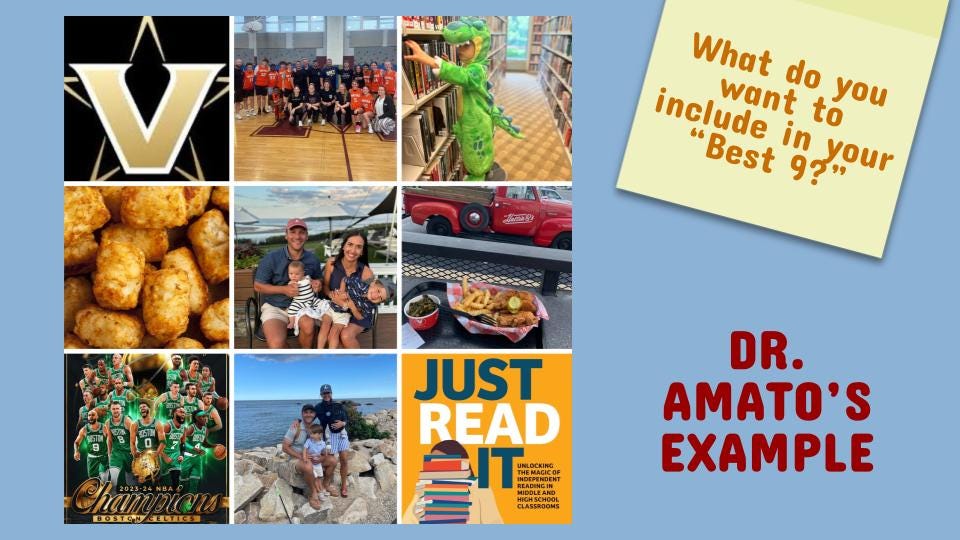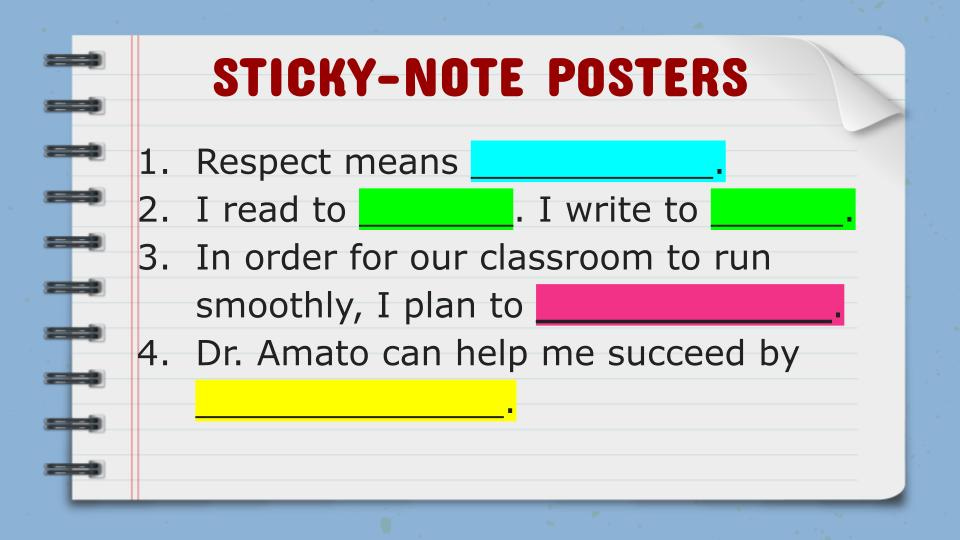Strength in Simplicity
Back-to-school activities, WRAP prompts, AoW tips, and more
Happy September everyone,
We welcome students tomorrow, so I am savoring the final few quiet moments here in my classroom before another year (I believe it’s year 17 although I truly have lost count) officially begins. I’ll save the sentimental reflection for another day; for now, I’ll say this: there is tremendous value in simplicity, particularly in today’s algorithmic age. For students, for ourselves, for all of us.
In this week’s newsletter, I’m going to share how I’m approaching the first few weeks and answer a few reader emails/questions. Let’s get right to it.
PART 1: Week 1-2 Game Plan
“Best 9” & “Books That Made Me”: here’s a simple template/organizer I created to help students brainstorm. (Final products are completed digitally via PhotoGrid, Canva, or a similar app/platform.)
Three Quick-ish Surveys: Interest Survey, Reading Attitude/Interest, and the most recent addition, Tech/Social Media/AI. *I’m open to feedback on any of the surveys, particularly the third one. Feel free to shoot me a quick email with any suggestions!
“This or That?” Debate & Persuasive Paragraph.
Begin “10 Things…” Letter. See the full rundown in last week’s update.
Sticky-Note Posters:
Respect means ___________.
I read to _______. I write to _______.
In order for our classroom to run smoothly, I plan to _____________.
Dr. Amato can help me succeed by ______________.
Interview Questions: Students generate thoughtful “interview questions” to ask their classmates and Dr. Amato. Not only does it help build community early on; it also serves as an introduction to our interview project, which we’ll begin in December/January.
Book Tasting Activity: Students will spend time previewing books in our classroom library AND our school library. The primary goal: I want every student to find at least one book they’re excited to start reading ASAP. AND I want them to find others to add their TBR list (which has its own page in their notebook). We will also start Fahrenheit 451 shortly, the central text in our first unit, “Reading, Writing, and Living in an Algorithmic and Artificial Age.”
Article of the Week (AoW) #1: Extended thoughts below (in part 3)!
Luca Scene Analysis. Again, the full rundown is in last week’s update. I’m also planning to re-watch this scene with my son as he works to overcome some of his fears :)
NWEA/MAP Testing.
PART 2: JARRED’S “CORE FOUR”
I’d love your help adding to the “core four” (Read and WRAP, AoW, poetry, grammar & vocabulary) documents that serve as the foundational pieces of my classroom. I created this Google form where you can submit your own WRAP prompts, AoW suggestions, and poems.
Here’s a weekly WRAP sequence for the 25-26 school year.
A couple of reminders: Over the past few months, I went through my book, Just Read It: Unlocking the Magic of Independent Reading in Middle and High School Classrooms (use the code RAVEN25 for 25% off + free shipping), and attempted to “place” or sequence the WRAP prompts intentionally — one per week for an entire school year. Take a look through the document and let me know if you have any questions, ideas, suggestions, etc. When you get to page 11, you will also find 30+ prompts that students can respond to on a sticky note/index card and that serve as excellent conversation starters. And when you get to page 13, you’ll see that I’m beginning to develop more prompts that combine grammar skills/concepts and literature analysis (two birds, one stone). Please reach out if you’d like to collaborate on this endeavor! For example, shout out to Carriann for setting up this incredible Padlet. Her message: “I started a padlet with all of the prompts you had sent out and included a few of my own. I thought this would be a good place for all of us to start posting ideas for new WRAP prompts. I only did the short ones we'd use for daily questions, not the longer weekly prompts. Anyway, feel free to share this with our collab group so we can have a huge list going!” THANK YOU!
Here’s a potential Article of Week “sequence” for the 25-26 school year, which includes thematic text sets/mini-units (pages 1-2) along with standalone articles and debate topics (page 3). You will also see my “year at-a-glance” on page 4 (more on this shortly). Again, complete this form if you have any questions, comments, suggestions, potential texts and topics, etc.
Here’s a beautiful collection of poems (more than 200!) that we can read and celebrate (and perhaps analyze) with middle and high school students throughout every “season” of a school year. Complete this form with any poems that we should add to the collection.
I’m also updating how I approach grammar (here’s my tentative sequence) and vocabulary (here’s our list of 100+ Greek & Latin morphemes). Will share more thoughts on this soon, I promise :)
PART 3: READER “MAILBAG” (Q & A)
Question 1: How often do your students WRAP? The short answer: every day. (Whether we’re reading a whole-class novel or self-selected books.) Sometimes it’s 30 seconds. Sometimes it’s 30 minutes. Most often, it’s somewhere in between. I’ll use this WRAP sequence, which I created over the summer, as a starting point. The goal is to have one “extended” prompt per week. Will we stick to this guide exactly? Most certainly not. However, it’s a great starting point for us. On the other days (when we’re not working on that extended prompt/task), we’ll lean a lot on the WRAP prompts listed on pages 11-12. My vision is a lot of quick responses, written on sticky notes and index cards, that promote conversation, collaboration, critical thinking, and creativity (I’m a sucker for alliteration). Prompts that help students process what they’re reading and that get them moving, whether it’s to get out of their seat and find a partner to share with or to place their sticky note on a bulletin board. And, as I mentioned earlier, I’m hoping to develop more prompts that combine grammar skills/concepts and literature analysis (two birds, one stone). Please reach out if you’d like to collaborate on this endeavor!
Question 2: How do you grade the AoW? The short answer: it depends! On “lighter” weeks (weeks where students are working on an essay or extended piece of writing), students may only read and annotate the AoW (I always print it out; nothing related to the AoW is completed digitally anymore). Other times, students may answer a few text-dependent questions (aligned to specific standards) and write two paragraphs — an objective summary and personal response. Or students may write a strong one-sentence summary and then a paragraph reflection. I love that the AoW is a constant for us, and I love that it’s flexible. (I know this is a short response so please know that I’m happy to answer more questions about the AoW!)
Question 3: What AoWs are you starting the year with? This is a tough one! I’m actually not sure. As I review set #1 (which continues to grow), I think there’s value in all of them :) Let me know if you have any suggestions. Of course, we can also print out several copies of each and have students choose from our collection. Lots of solid options and possibilities.
PART 4: UPDATES & REMINDERS
For those who missed last week’s webinar, here’s a message from our friends at the King County Library System: The recording is available until September 30, 2025. Please help us spread the word; share the link with your network! Dr. Amato also joined us for an event at the beginning of June. You can watch that recording until September 30. You can find links to both recordings and the resources and books shared during them here.
Be on the look out for virtual planning sessions throughout the school year. I’m thinking that we’ll stick with Tuesday nights. In the meantime, please continue to reach out with questions, ideas, recommendations, etc.
On another note, please let me know if your school, district, or organization is planning a JUST READ IT book study or would like for me to deliver a keynote address and/or lead a workshop/PD session in 2025 or 2026. Feel free to share this letter with your school and/or district leaders. I love connecting with fellow educators and supporting/strengthening your team’s literacy efforts.
Finally, if you have a moment, I’d love for you to leave a review of Just Read It.
That’s all I’ve got for now. Appreciate each and every one of you.
Cheers,
Jarred




I was wondering if you'd mind sharing how you allocate time in class on a typical day when you get into your routine. Particularly, how much in class VS out of class time is devoted to AoW?
Great question! It depends on the specific class. Some can complete nearly everything independently outside of class and others need much more support. But I’d say this: I try to carve out time IN CLASS for an initial reading and discussion (minimum 15-20 minutes) early in the week and then some time later in the week to check in, revisit, reflect, clarify, etc. If it’s the core text and focus for the week, then we obviously dedicate more in-class time/energy. If we think in terms of percentages, the AoW is maybe 10-20 percent of our total class time? (And I’d say Read and WRAP is roughly 25-30 percent.)